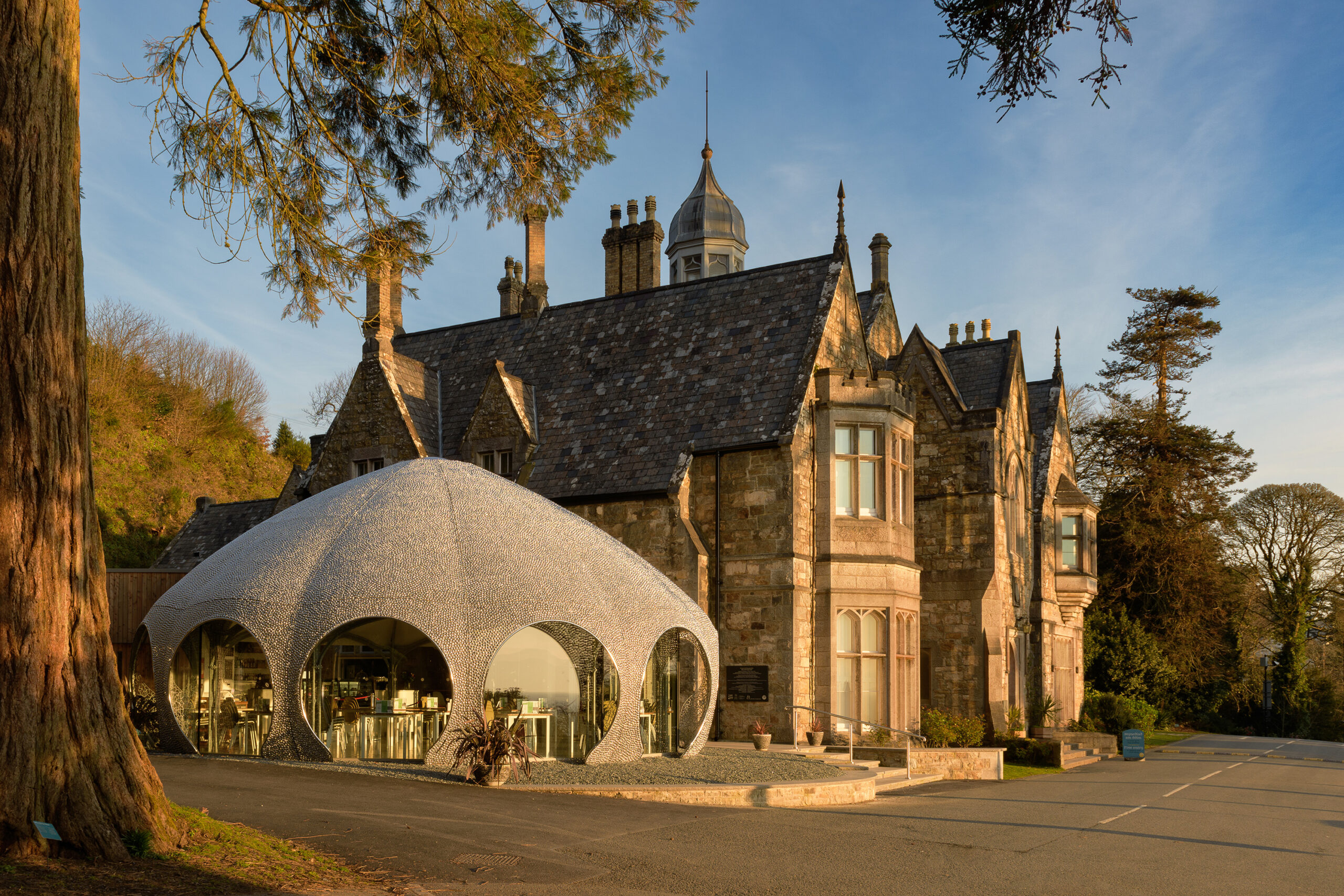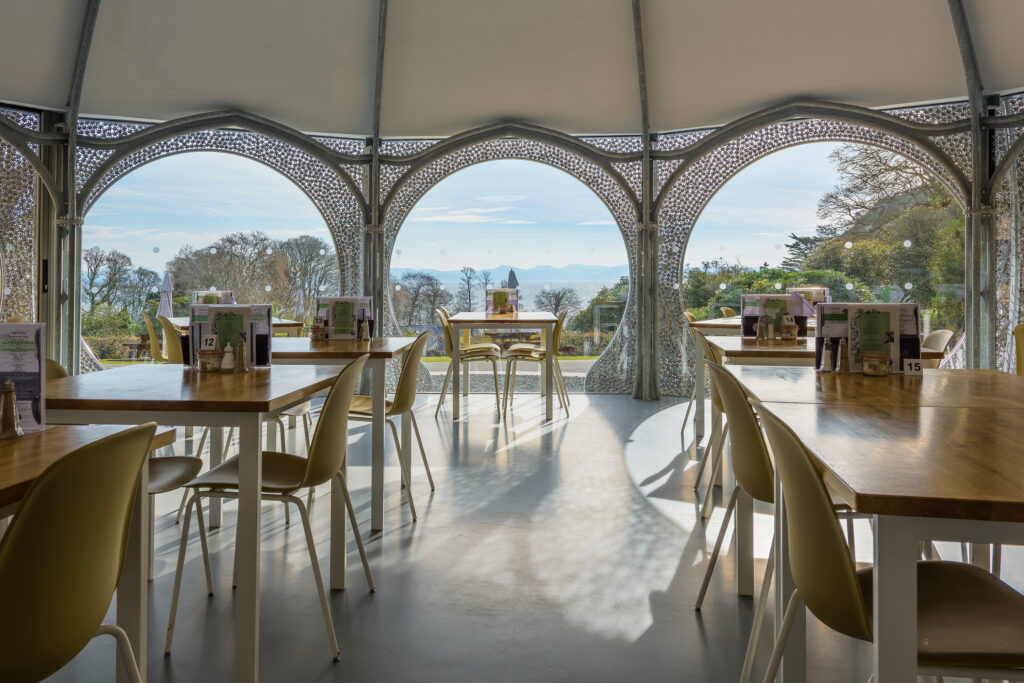The café at the gallery and performing arts venue Oriel Plas Glyn-y-Weddw, on the north Wales coast, takes inspiration from the local marine wildlife and the spirit of scientific discovery and exploration during the time of the Victorian building’s original construction. Attracting local residents and visitors alike, the café was built on a JCT Intermediate Building Contract with Contractor’s Design.
Oriel Plas Glyn-y-Weddw’s new café replaces a replica conservatory originally built in the 1980s. Its limited capacity and poor environmental performance led to a rethink, and a radical new design, conceived with help of a local artist, provides the gallery with a vibrant social enterprise and an important resource for the local community. It is a modern addition to the rest of the Victorian façade, but one that nonetheless reflects the spirit of the Centre’s commitment to local arts, culture, and reflecting its surroundings.
Oriel Plas Glyn-y-Weddw – a brief history
- An independent arts centre, the oldest gallery in Wales. The Grade II* Listed mansion was built in 1856-57 for Lady Elizabeth Love Jones-Parry as a Dower House and to display her extensive collection of artwork.
- The original building was designed by architect Henry Kennedy.
- Cardiff businessman Solomon Andrews bought the house in 1896, turning it into a public gallery.
- The gallery was closed during the Second World War and subsequently went into disrepair. In the 1970s local artist Gwyneth ap Tomos and her husband Dafydd acquired the house and re-opened the gallery in 1984, which evolved into the current charitable trust in the 1990s.
- Today, the Centre has multiple roles: an art gallery exhibiting the work of contemporary Welsh artists, a museum, and performing arts venue.
The initial designs for the new café were developed by artist Matthew Sanderson. Sanderson’s research into the societal, architectural, and scientific trends of the period that the original mansion was built, was a key influence for the project. In particular, the themes of scientific fascination, exploration, collecting, and their interpretation into the decorative arts came to the fore. Charles Darwin’s ‘On the Origin of Species’ was published just two years after the original mansion was built, and his contemporary, Ernst Haeckel, marine biologist and artist, was discovering and illustrating thousands of new species.
The historical influence was combined with the marine life found today in the local area. The southeast facing Llanbedrog Bay is part of a special area of conservation and host to many species unique to the area. The sea urchin specifically was one such creature who inspired the café’s 11m-wide self-supporting structure. Sanderson worked in collaboration with Mark Wray Architects, who are experienced in working with listed and historic buildings, and consulting engineers FOLD to develop the design and delivery of the project.
The outer shell is the most dramatic element of the pavilion’s exterior. A colony of 89,000 ‘acorn barnacles’ – individually punched and pressed components – are welded to the subframe to create a highly polished and textured finish. The surface created scatters natural light and helps to minimize solar gain. The material used – recycled marine-grade 316 stainless steel – is also resistant to the chemical and physical weathering that would be encountered in a coastal setting.
Inside, natural light is dispersed throughout via a central oculus in the ceiling, which also opens to assist in passive ventilation during warmer weather. From this central point, 12 sculptured beams fan out to meet equivalent columns. These are connected via four-pointed arches that subtly reflect the gothic style of mansion house. The thermal envelope that sits between the shell and structure is a combination of faceted SIP panels that follow the curve of the roof. They are finished internally with acoustic plaster. Between each arch, discreet frameless glazing provides portal views of the surrounding coast and woodland.
A light touch is employed where the café interacts with the existing fabric. A linear circulation route has been created between the new facility and the main house. The centre point of the café’s seating area is aligned with an existing cusped arch doorway which leads to the gallery spaces. The development of the café also provided the opportunity to upgrade some of the centre’s other facilities. New WCs within the mansion building are accessed via the café through an open colonnade to the rear. This enables flexible and fully accessible use of the whole centre.
Themes of combining history with modern techniques and creative approaches are found in many projects using JCT contracts. In similar vein, the history of JCT contracts provides the level of precedence and stability that a project requires of a contract, but it’s continuing evolution and contribution from all areas of the industry enables projects embracing a modern approach to rely on JCT contracts with confidence.
Project Summary
Start on site: October 2020
Completion date: October 2022
Gross internal floor area: 240m²
Contract: JCT Intermediate Building Contract with Contractor’s Design
Construction cost: £1 million
Artist: Matthew Sanderson
Architect: Mark Wray Architects
Client: Trustees of Oriel Plas Glyn-Y-Weddw
Main contractor: Henry Jones Builders (phase 1), OBR Construction (phase 2)
Structural engineer: FOLD Engineering
M&E consultant: KGA (up to Stage 4)
QS/CDM co-ordinator: Adeiladol Cyf
Kitchen design: Chris Chown
Approved building inspector: Quadrant Building Control
CAD software: Vectorworks
Images: Gareth Jenkins


